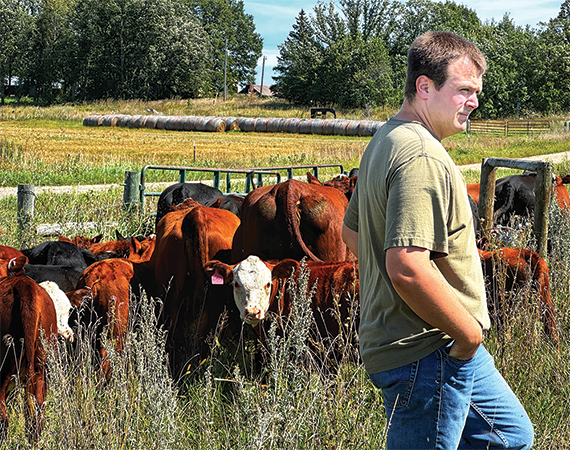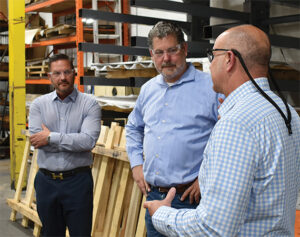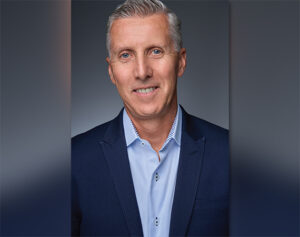On a farmer’s quiet pasture in north central Minnesota, a cow munching on a dense layer of grass and clover defecates and lets out a lazy moo.
Moments later, a fly gets wind of the latest bovine byproduct and buzzes by to inspect.
Finding said byproduct a hospitable holding area for fresh larvae to feed and grow, the fly lays a hundred or so eggs before flapping its wings and flying off into the humid summer air.
Days later, a farmer moves that herd of cows to another pasture and brings his chickens in to feed where the cows once grazed.
As the chickens roam among the growing clover and grass, the larvae in the cow pies have now matured into maggots — the perfect chicken feed. The chickens peck through the manure to find the maggots. The ones they find, they eat. The ones they don’t may grow to become flies, flies that may one day buzz through this same pasture, find a cow pie — maybe even from the same cow — and the circle of life continues. (And as a bonus: The swarms of mature flies feeding on and irritating the festering hides of grazing cows are diminished greatly, as many of those cow-pie maggots never escaped the darting beaks of hungry chickens.)
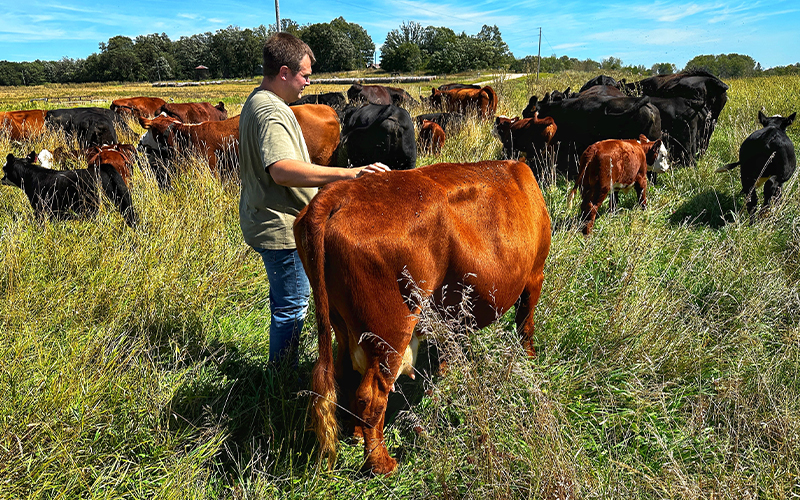
While some may find this story a tad on the grotesque side, its exquisite efficiency is actually quite beautiful. The grass feeds the cow. The cow’s waste feeds the flies. The flies’ larvae feed the chickens.
Far from a made-up scenario to make a point, this story illustrates the vision of Enterprise Minnesota business growth consultant Eric Blaha, and this circle-of-life situation happens very much by design. It’s an example of how Blaha uses the principles of “lean” — designing and arranging work areas and practices to maximize efficiency — to best utilize resources.
“The plants feed the pasture, so I’m not having to apply nutrients,” Blaha says. “I’m eliminating a wasteful pass of transportation. The cows are picking their own feed. I’m eliminating transportation feeding cows. And the chickens are turning a waste resource into valuable protein that I can feed my family with or that I can sell to someone else to feed their family.”
Blaha is unique among consultants. Raised on a farm just a few miles from where he now lives with his wife and two kids, Blaha’s “farm kid” values define his work ethic and inform his expertise as a consultant.
Growing up on a farm isn’t the typical route to becoming a business growth consultant. But that’s the beauty of Blaha’s ethos. Nothing comes more naturally to a farmer than growth. He’s driven by results, not afraid to take calculated risks, and, in his own words, is always striving for improvement, making manufacturers more profitable by day, and ruling over 300 gorgeous acres of farmland in his spare time.
Verndale strong
Before he purchased his farmland and home in rural Verndale, population 600 or so, Blaha grew up on an 80-acre “hobby farm” just a few miles away. Growing up there was a great model, he says, for how he wanted to raise his own family. Luckily, he found the right partner the day he walked into Verndale Elementary School.
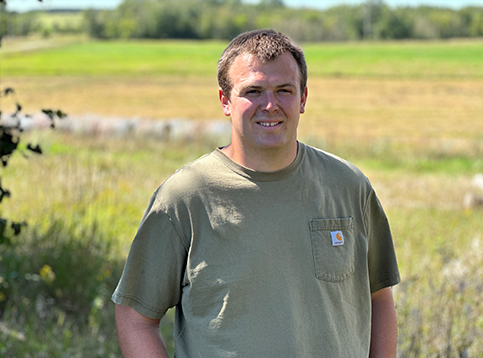
He’s known his wife almost as long as he’s been alive. It surprised no one when the two married and started a family. While Eric works the fields and tends to his Enterprise Minnesota clients, Angela tends to the children as well as the vegetable garden, where cucumbers, tomatoes, melons, broccoli, peppers, and beans eventually make their way to waiting customers. (The Blahas also sell meat from their cattle and eggs from their chickens.)
After graduating from Verndale High School, Blaha earned a bachelor’s degree in agricultural engineering from North Dakota State University. What he did not earn was street cred from the party scene.
“Didn’t party at all. Never went to a football game,” Blaha says. “I played a lot of sports in high school. I like to do things. It’s never been that intriguing to me to watch other people do things. I’d rather be out there doing something.”
To illustrate that sentiment, Blaha admits he didn’t watch a single event in the recent Olympics. “I was out putting in my waterline the whole time the Olympics were on. I just don’t find that much joy in watching others do things.”
During college Blaha worked for the Case New Holland (CNH) farm tractor manufacturing company, first as an intern and later a full-time employee. He worked in quality assurance and operations management for CNH.
After five years he took a job with Stern Assembly. Two years later, Enterprise Minnesota hired him.
Blaha says his breadth of experience and work ethic likely caught Enterprise Minnesota’s eye.
While working at CNH, Blaha got the opportunity to travel and observe lean principles in a variety of settings. Eventually, when he became Stern’s plant manager, he applied what he’d learned about lean. He improved his skills at securing employee buy-in and became an evangelist for the “touching once” mentality and relaying out the facility for optimal utilization.
“All those different things fit really well and nest really well in lean manufacturing,” Blaha says. “And I just kind of took that stuff and ran with it.”
John Connelly, Enterprise Minnesota’s vice president of consulting, says Blaha’s work ethic and zeal were obvious.
“Right off the bat meeting Eric I was struck by how engaging he is,” Connelly says. “When it comes to continuous improvement, Eric can converse all day long. His strong work and application experiences provide great perspective to analyze processes and consider progress from many angles. And he presents his ideas logically and thoroughly. A conversation with Eric leaves you something actionable, valuable.”
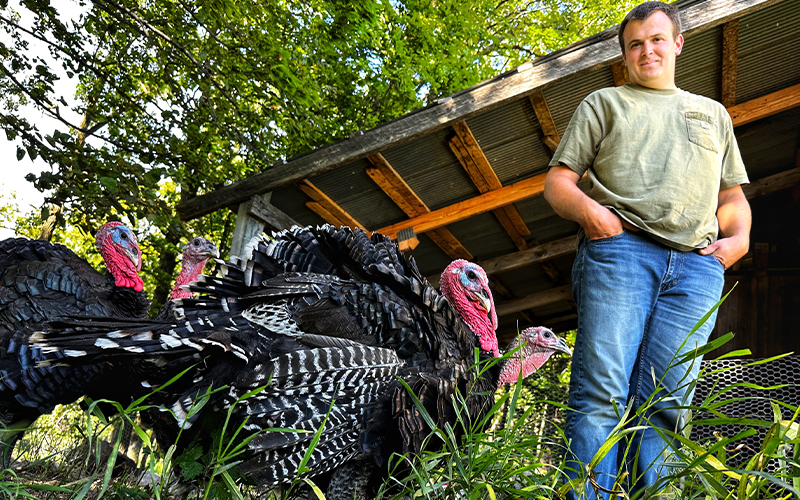
Outside the box
The way Blaha has “run with it” has garnered plaudits from his clients. And there is no better example than “the race,” a gambit he conceived to convince line workers at Lind Electronics in Minnetonka that their packaging process was less efficient than what is known as “single piece flow.”
Blaha and fellow Enterprise Minnesota consultant Kari Rusing, rank amateurs in the packaging game, raced the seasoned veterans, men who had packaged hundreds of thousands of items to ship. The veterans won, but not by much. “The race,” Lind Electronics general manager Joe Carlin says, created a “transformational moment.” Blaha’s simple idea, an idea that required them to take a new, fresh look at the kind of growth that can come from a different perspective, led to concrete results for Lind.
Taking a different look at a problem has sort of become Blaha’s specialty. One need only look at the way he farms to see this principle at work.
Driving through the pastoral acres of Wadena County, there is a familiar uniformity of farming that has fed Americans for centuries: Brown-black dirt, arrow-straight rows of planted corn or soybeans, and farmers using time-honored methods to work fields and harvest crops.
Blaha’s methods, however, are slightly unorthodox.
You won’t see any black dirt on Eric Blaha’s fields. It’s certainly there, but it’s covered by beneficial vegetation that will not only enrich the soil but eventually become feed for his herd of cows.
And he’ll still plant seeds in these fields. Just not in the way most farmers do. Blaha utilizes a concept called “no-till” farming. Where most farmers will run first a plow and then a disc through the soil, Blaha does none of that. Instead, he lets nature — and hooves of 30 cows (and one bull) — trample the grass and contribute to the process of making it dense through added growth and managed cow consumption.
To add that growth, Blaha uses a special tool to cut through and plant additional seeds.
“I have a seed drill that’s specifically designed for planting in no-till fields,” he says. “Imagine a knife blade with 2,000 pounds of force on it that cuts through the residue. Behind that is what’s called the seed boot, which puts the seed in the trench.”
Maintaining fields this way combines a consultant’s eye and a willingness to resist the millennia of momentum nudging farmers in a particular direction. It requires patience. And it requires a farmer to want to do it.
Changing minds about something as ancient as farming can be like moving a mountain. But Blaha says that great benefits await those willing to face new farming frontiers.
“It requires you to want to do it, to want to go move your cows every day, or move them more than you have to,” he says. “You have to believe it will work, and you have to have enough patience to see it start to work. I’m in year five now, and it’s really starting to take off, but you have to be patient enough and willing enough to put the effort into those first few years.”
He admits, though, that some farmers don’t have the luxury to transform their acreage into a system of farming that might work. After all, Blaha isn’t just a farmer. He has a full-time job and a dedicated partner tackling a monumental job herself.
“A lot of full-time farmers can’t afford to have a couple of down years while they get the soil working for them, not against them. I can afford to have 10 acres that don’t do well for a year or two because it’s not going to affect me being able to feed my family.”
Self-sustaining cows
If you work on a manufacturing shop floor you’re bound to hear a “lean” consultant utter these words: “Don’t move things more than you have to.” Blaha doesn’t just believe those words, he’s put them into practice in several ways.
Consider how he feeds his cattle. Most farmers feed their cattle in a pen or barn, which may seem efficient. But in Blaha’s thinking, cows that aren’t in the pasture aren’t depositing their waste where it can provide nutrients to the soil. Blaha’s stock eat from bales of hay at strategic spots across his acreage. He’ll deposit all the hay in one day, instead of hauling hay daily.
“I started thinking, ‘Well, I move [the hay] to a stackyard, and then I move it out to the pasture, so I’m moving it more than I have to.’ So then I just took it and placed it out there, skipping the stackyard step. And now I’m really happy that’s done, because that used to be a full Saturday in October.”
This approach eliminates labor from feeding cows in the wintertime, and deposits nutrients right where he wants them: on the pasture.
“You also don’t have to clean the poop, put it in a manure spreader and haul it out to a field and spread manure,” he says. “They’re spreading it for me. They’ve got four legs. Why would I haul them feed and then haul their poop away? Make them go get the food and spread their own poop.”
Blaha concedes that he’s very much in the minority among farmers. He also concedes that his method is likely wasting more feed than farmers who employ more traditional methods. But he’s quick to point out that farmers, historically, have been remiss in accounting for one crucial thing.
“Farmers tremendously devalue their time,” he says. “They don’t account for it when they count break-evens and costs.” Blaha’s feeding schedule completely eliminates his time from the equation, he says. “I don’t spend any time feeding them. I don’t have an expensive TMR mixer on a tractor for feeding that I have to account for in my budget. That doesn’t exist for me.
“I want my cows to fend for themselves, take care of themselves, and then I’ll just give them the necessities,” he says. “Most farmers work really hard and spend all their time to save a penny, but they’re missing the dollar.”
Blaha has also invested significant time and money in a plumbing system that delivers water to the cows.
Over the course of several months, Blaha dug trenches and ran water lines. He believes a costly up-front investment will save him money in the long run by not having to haul water. It will also make for happier cows, he says.
“The water line was a huge one. I never have to haul water again.”
Light reading
A few years back, Blaha was on a plane flying to Europe. In flight, he started reading a book he’d purchased called, Dirt to Soil: One Family’s Journey Into Regenerative Agriculture by Gabe Brown.
The book changed the way he looks at not just farming but his work as a consultant for manufacturers, as well. One concept stood out.
“Brown wrote that 78% of our atmosphere is nitrogen, and that most of the nutrients farmers apply to their soil is nitrogen,” he says. “Why, then, with so much natural nitrogen all around us — including in plant life — are we paying for it? Why not let the naturally occurring nitrogen that’s already there feed the soil’s need for it?
“And that’s what got my head spinning,” Blaha continues. “From there I started thinking about all the different things that we did in agriculture that didn’t make sense.”
With his background as a lean expert, combined with reading the right book at the right time, Blaha honed his craft as a consultant and reimagined how his own farm could make more sense.
The end result looks something like the cow-maggot-chicken scenario. Blaha’s agricultural upbringing ingrains a “growth first” mentality, which in turn makes him very good at helping manufacturers become more profitable. More profitable manufacturers hire more workers and maybe even raise pay. Better paid and happier workers spend more money in the community. And with a few of those dollars, they purchase a dozen eggs and some grass-fed ribeye steaks from Blaha.
Return to the Winter 2024 issue of Enterprise Minnesota® magazine.
